pzgr40
Well-Known Member
The PT MI K is a Czech metal cased anti tank blast mine. The mine consists of a doughnut shaped sheet metal mine body. In the hole in the middle the RO-5 fuze is placed. The RO -5 is a combination of a pressure fuze with shear wire, detonator and booster charge in one. After placing the RO-5 fuze in the mine body, the pressure grid is placed. The pressure grid consists of a cross shaped pressure spider, connected to a circiular bellow, that is pushed inward when pressure is applied to the top of the pressure grid. This pressure is translated to the top of the pressure fuze, up to the moment a break wire is sheared off, releasing the spring loaded firing pin to move into the duplex detonator. This ignites the booster and the mine.
Below the cross shaped pressure spider a leaf spring with two downward pointing fingers is placed, pushing the RO-5 fuze downward, preventing the fuze from moving upward after it has been placed in the mine.
The RO-3 anti lifting switch is screwed into the base of the RO-5 mine fuze, and prevents the mine from being lifted. If the pressure spider is loosened and removed and the RO-5 fuze is lifted, -either the complete mine is lifted- the outer housing with the flange of the RO-3 will be pushed downward by the firing pin spring up till the moment that both steel balls can escape, releasing the firing pin to move into the firing cap in the base of the RO-5, igniting the detonator, detonating the mine.
The Ro-3 is activated by pulling away the safety pin stuck through the firing pin by means of a rope, after one made shure the Ro-3 is placed firmly on a hard surface below the mine.
Diameter : 300mm
Height : 102 mm
Weight mine : 7,2 kg
Explosive charge : 5 kg TNT
Activation pressure : 330 Kg
The PT MI K is found in the following countries:
Afghanistan, Cambodja, Eritrea, Namibia, Nicaragua, Western Sahara
Regards, DJH
Below the cross shaped pressure spider a leaf spring with two downward pointing fingers is placed, pushing the RO-5 fuze downward, preventing the fuze from moving upward after it has been placed in the mine.
The RO-3 anti lifting switch is screwed into the base of the RO-5 mine fuze, and prevents the mine from being lifted. If the pressure spider is loosened and removed and the RO-5 fuze is lifted, -either the complete mine is lifted- the outer housing with the flange of the RO-3 will be pushed downward by the firing pin spring up till the moment that both steel balls can escape, releasing the firing pin to move into the firing cap in the base of the RO-5, igniting the detonator, detonating the mine.
The Ro-3 is activated by pulling away the safety pin stuck through the firing pin by means of a rope, after one made shure the Ro-3 is placed firmly on a hard surface below the mine.
Diameter : 300mm
Height : 102 mm
Weight mine : 7,2 kg
Explosive charge : 5 kg TNT
Activation pressure : 330 Kg
The PT MI K is found in the following countries:
Afghanistan, Cambodja, Eritrea, Namibia, Nicaragua, Western Sahara
Regards, DJH
Attachments
-
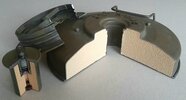 01 - PT MI K mine in parts.jpg1 MB · Views: 43
01 - PT MI K mine in parts.jpg1 MB · Views: 43 -
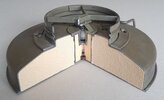 02 - PT MI K mine as laid.jpg793.7 KB · Views: 44
02 - PT MI K mine as laid.jpg793.7 KB · Views: 44 -
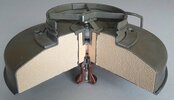 03 - PT MI K mine with Ro-3 anti lifting device.jpg827.4 KB · Views: 44
03 - PT MI K mine with Ro-3 anti lifting device.jpg827.4 KB · Views: 44 -
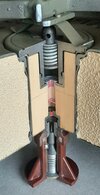 04 - Detail Ro-5 mine fuze and RO-3 anti lifting device.jpg1 MB · Views: 42
04 - Detail Ro-5 mine fuze and RO-3 anti lifting device.jpg1 MB · Views: 42 -
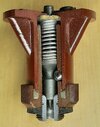 05 - Ro-3 anti lifting device.jpg619.6 KB · Views: 41
05 - Ro-3 anti lifting device.jpg619.6 KB · Views: 41
